Hole in the Clouds
Oct 31, 2010
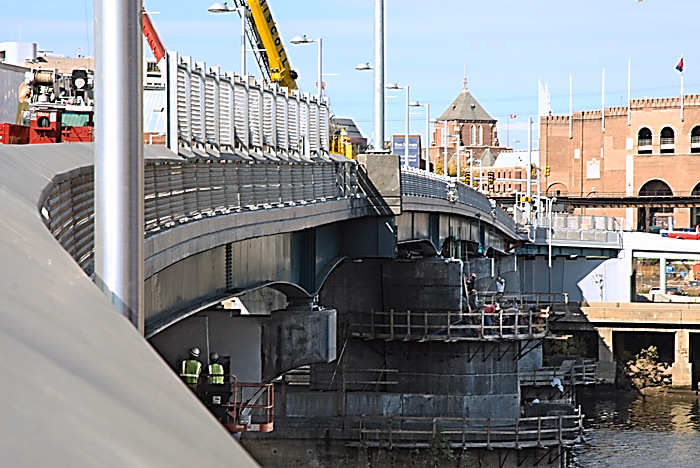
Two years ago, when they demolished the old South Street Bridge over the Schuylkill River, it was in such bad shape, I'm told, that chunks of its concrete were falling onto the expressway that passes underneath.
A week from Monday, this new South Street Bridge is scheduled to open, restoring a direct route from our neighborhood to the University of Pennsylvania across the river. The little flag near the right edge of the picture is flying over Penn's football stadium.
Looks like there's still a little work to be finished up in this next week. But they say they'll cut the ribbon right on schedule.
cityscape
Philadelphia
Schuylkill River
bridge
construction
Feb 2, 2011
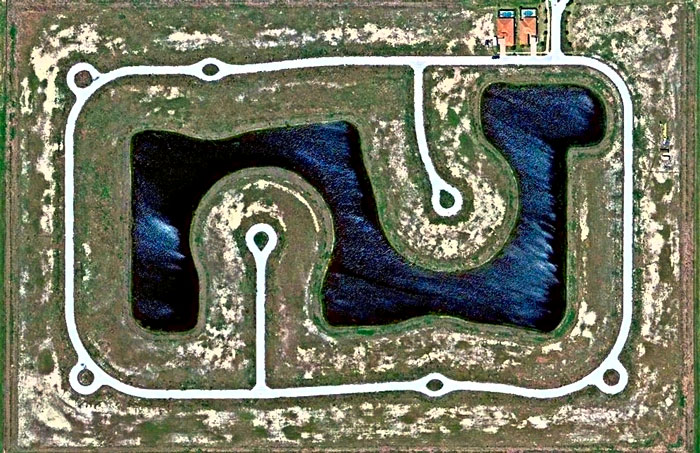 This is a picture of a real estate bubble. There have been land bubbles in Florida since forever; what we're looking at here is just the bubble du jour, a subdivision near Fort Myers, on the Gulf Coast, where the developer put in the roads and the "lake" and the cul de sacs and managed to build two houses complete with swimming pools before it was all over.
This is a picture of a real estate bubble. There have been land bubbles in Florida since forever; what we're looking at here is just the bubble du jour, a subdivision near Fort Myers, on the Gulf Coast, where the developer put in the roads and the "lake" and the cul de sacs and managed to build two houses complete with swimming pools before it was all over.
I read today that 11 per cent of the housing units in the United States are currently unoccupied. So it's really over. For a while.
birdseye view
construction
(h/t:The Big Picture at boston.com)
Florida
economics
sprawl
Fort Myers
(Image credit: Florida Dept. of Environmental Protection)
Jan 12, 2012
 Pigeons take care of a freshly poured concrete sidewalk in Los Angeles, January 17, 1956.
Pigeons take care of a freshly poured concrete sidewalk in Los Angeles, January 17, 1956.
streetscape
construction
1956
birds
sidewalk
Los Angeles
(Image credit: John Malmin, Los Angeles Times)
Apr 25, 2012
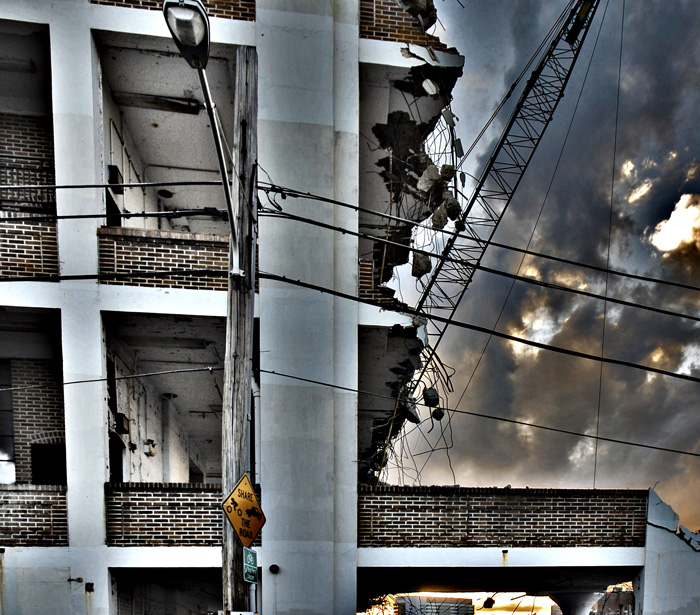 Where this building now almost stands and in the streets around it, back in the day, the neighborhood kids used to be so bold and bad that the parish priest described them as children who'd steal a chain from right out of the devil's pocket. And so this part of the neighborhood got its name, Devil's Pocket, which was home to poor people, of course, mostly Irish immigrants.
Where this building now almost stands and in the streets around it, back in the day, the neighborhood kids used to be so bold and bad that the parish priest described them as children who'd steal a chain from right out of the devil's pocket. And so this part of the neighborhood got its name, Devil's Pocket, which was home to poor people, of course, mostly Irish immigrants.
A generation or two later, a bunch of the little old houses in Devil's Pocket were torn down to build a parking garage, apparently intended for employees of the old Graduate Hospital. Most of that hospital is long gone, and now, in the spring of 2012, the wrecking ball has come for the derilict parking garage.
It sounds a little cheeky, but by this time next year, there will be fancy new condos right here in the Devil's Pocket. And the wrecking ball will toll for some other something.
cityscape
streetscape
demolition
Philadelphia
construction
neighborhood
Graduate Hospital
urban decay
Apr 27, 2012
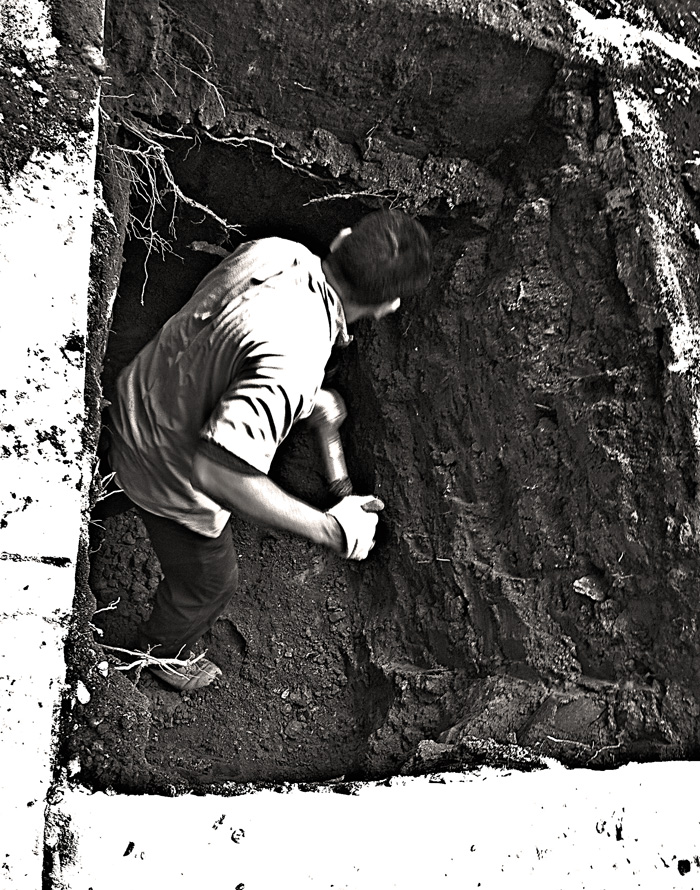 "Video pipe specialist," says the sign on the side of Mr. D's plumbing truck. "We can see underground."
"Video pipe specialist," says the sign on the side of Mr. D's plumbing truck. "We can see underground."
The truck and a backhoe blocked Kater Street for most of the day yesterday, but the job didn't look too video-intensive. According to the man with the shovel, who ought to know, "a couple of feet" of sewer line needed replacing under the sidewalk in front of a house. According to the new owner of the house, the problem had been picked up during a pre-sale inspection, forcing the old owner to foot the bill. "Up to a limit," said the new owner. "This just better not go over the limit."
By late afternoon, the backhoe had filled the hole, and the new owner was standing in his new doorway, roller and empty paint tray in one hand, phone in the other. "It went great," he said, while he texted one-handed. "Soon as I finish the painting we can move in."
streetscape
Philadelphia
Kater Street
work
construction
plumbing
digging
Sep 15, 2013
 We have nothing to say.
We have nothing to say.
cityscape
streetscape
construction
airplane
mystery
Oct 25, 2013
 We went to Chicago last weekend for a family wedding, a proverbial happy occasion. The town was bustling with big goings-on; for example, the night before "our" event, there was another wedding at the same downtown hotel, a high-concept sort of wedding in which the bride and everyone else was wearing black. Also at our hotel, an MLS soccer team had taken up residence, visiting from Toronto for a game against the Chicago Fire (the Fire won, 1-0).
We went to Chicago last weekend for a family wedding, a proverbial happy occasion. The town was bustling with big goings-on; for example, the night before "our" event, there was another wedding at the same downtown hotel, a high-concept sort of wedding in which the bride and everyone else was wearing black. Also at our hotel, an MLS soccer team had taken up residence, visiting from Toronto for a game against the Chicago Fire (the Fire won, 1-0).
And then there was the happy occasion seen here, which included a Saturday morning photo session in front of Millennium Park's "Cloud Gate," aka the bean.
Seven years ago, when this tourist magnet first opened, photographers were required to get $350 permits and schedule their shoots in advance. Annish Kapoor, the artist who designed the bean, controlled his work's copyright and attempted to limit its reproduction. But the bean is nothing if not a photo op, and Kapoor quickly had to back off his restrictions; currently, you don't need a photo permit unless you are part of a film crew of ten or more people. The thousands of visitors every day who pull out their cellphones aren't breaking any laws.
The perfect shine and complex globular shape of the bean were inspired by drops of mercury, according to Kapoor, an Indian-born British sculptor. He thinks the popular name for his work, bean, is idiotic. He named it "Cloud Gate" because most of its polished stainless steel surface reflects, and distorts in odd ripply ways, sky and skyscrapers. Visitors are mostly interested, however, in how it reflects them, especially in the arched middle section, which reflects reflections of reflections in crazy, curvy ways much too complicated to figure out.
The plaza in which the bean sits is actually the roof of a restaurant and parking garage, and it had to be seriously reinforced to support 110 tons of highly polished stainless steel. After the reinforcing, computer-aided robots spent a year bending and welding together 168 steel plates, and after the welding, a crew of humans with sandpaper spent more than a year polishing the plates. After all the polishing, the welding seams became completely invisible, an accomplishment that won the work an Extraordinary Welding Award from the American Welding Society.
The lower part of the bean, where people leave fingerprints, is washed every day with Windex. The upper part, where air pollution and birds jeopardize the polish, is washed twice a year with liquid Tide.
If you want to rent it for a day just for yourself and your friends, the city charges $800,000. Twice so far, since opening day in 2006, people have paid that rent. The rest of the time, everybody's welcome, free of charge.
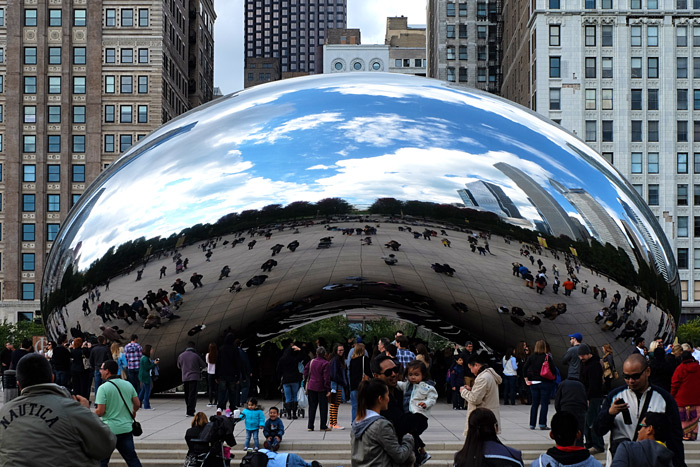
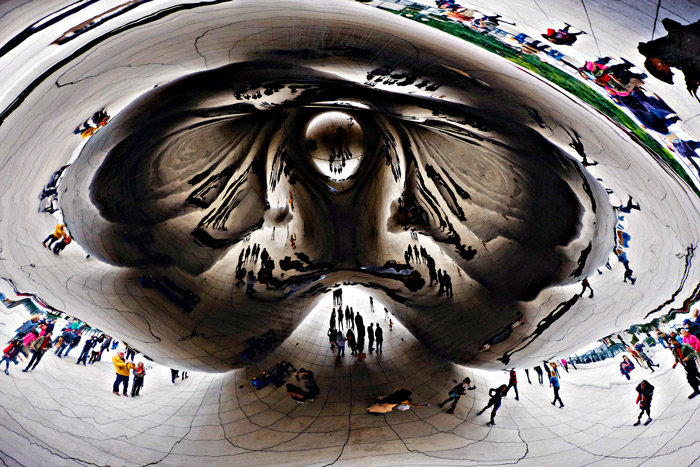
Chicago
wedding
sculpture
construction
photography
Cloud Gate
public art
Annish Kapoor
Millennium Park
(Image credits: Little Fuji)
Jun 19, 2014
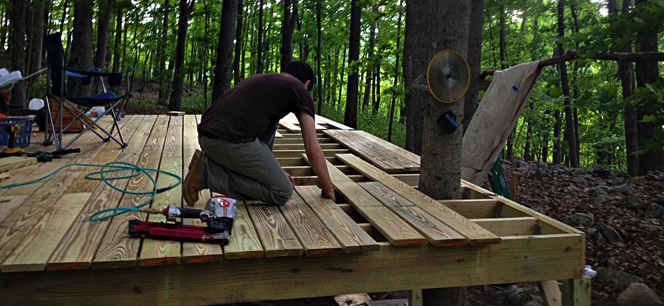 Ted lines up the decking for the new deck he's building behind his house high on the mountain near Berkeley Springs, West Virginia. "There is a big hickory and a skinny maple growing through the deck," he notes. "I still haven't done the railing. Sigh."
Ted lines up the decking for the new deck he's building behind his house high on the mountain near Berkeley Springs, West Virginia. "There is a big hickory and a skinny maple growing through the deck," he notes. "I still haven't done the railing. Sigh."
West Virginia
Ted
work
construction
woods
deck
Berkeley Springs
Jul 4, 2014
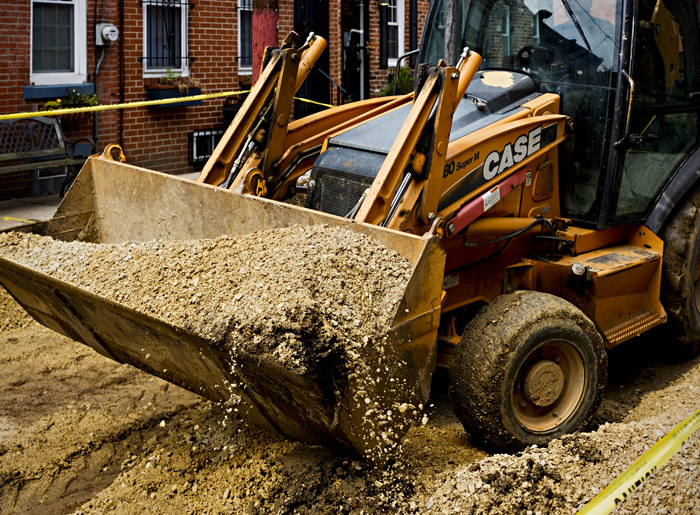 It's an important project, replacing century-old water mains underneath this stretch of Kater Street near us. It's also been a crazy dragged-out project, beginning last fall and not quite finished yet.
It's an important project, replacing century-old water mains underneath this stretch of Kater Street near us. It's also been a crazy dragged-out project, beginning last fall and not quite finished yet.
In the wintertime, the digging had exposed the water main and also the connecting water lines that served houses all up and down the street. Of course the pipes froze. Repeatedly. Ice and snow interrupted the work, repeatedly, often leaving our neighbors with no water.
In the springtime, the neighbors enjoyed the noise of heavy equipment at their doorsteps, all day, every day. All but one of the trees on the block were cut down. There was mud when it rained and dust when it didn't rain, and of course no parking.
Now it's July, and the workmen have closed their hole back up and are finally preparing the block for new asphalt and curbs and sidewalks. They promise new trees next fall.
All along, the work has been hard: cold, hot, and dangerous, with people living right there in the construction site. The street is so narrow and the houses so close to the hole that the excavator has to back up all the way to the end of the block to turn around between scoops of dirt.
As hard as it is, it's critical work for our children's future. We need a whole lot more investment like this, or our problems will no longer be the first world sort of problems.
Happy birthday, America.
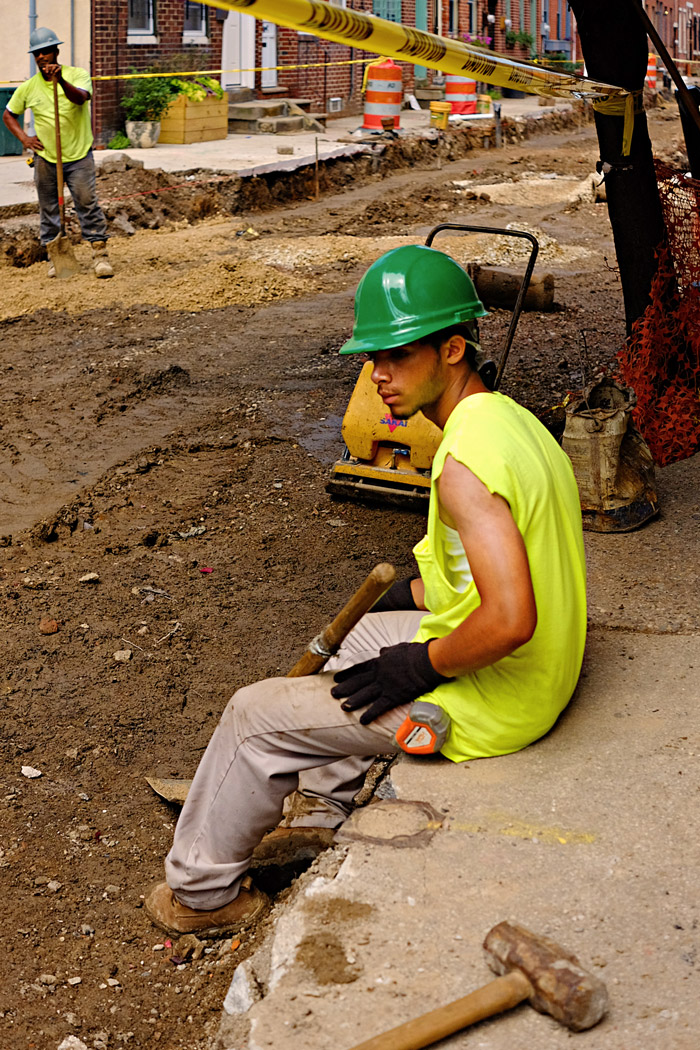
streetscape
Kater Street
work
construction
Philly
dirt
(Image credit: Little Fuji)
Apr 30, 2015
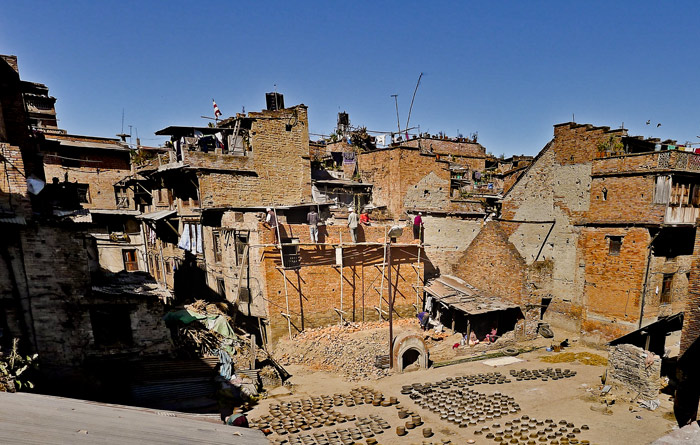 In the best of times, such as when this photo was taken about four years ago, repairing houses and other buildings in Nepal involved scaffolding made from stalks of bamboo lashed together.
In the best of times, such as when this photo was taken about four years ago, repairing houses and other buildings in Nepal involved scaffolding made from stalks of bamboo lashed together.
In the worst of times, such as right now, even this sort of construction work is an unimaginable luxury; all hands, and all hours of the day, are consumed by pawing through rubble, hoping or fearing to find relatives and friends and neighbors, and also hoping to find scraps of food and clothing and blankets, anything that might help the survivors cling to life.
There's nowhere to look for the basics of survival except in the rubble. There was no surplus of anything in Nepal to begin with, and only a single sizable airport for bringing relief in from the outside world.
Before these men could climb up on the scaffolding to lay brick, the sacks of mortar had to be brought in on the backs of people or donkeys; the streets here in this UNESCO World Heritage city of Bhaktapur, near Kathmandu, were much too narrow for cars or trucks.
Now even the country's best roads are ruined, and travel through the narrow lanes and paths is generally impossible. Some villages that used to be a day's walk or more from the nearest highway have not been heard from since the quake.
Bhaktapur was once a great royal court city; grand palaces and temples survived there for more than a thousand years. They're not there any more.
Nepal
earthquake
work
construction
Bhaktapur
damage
scaffolding
(Image credit: E)
Apr 6, 2016
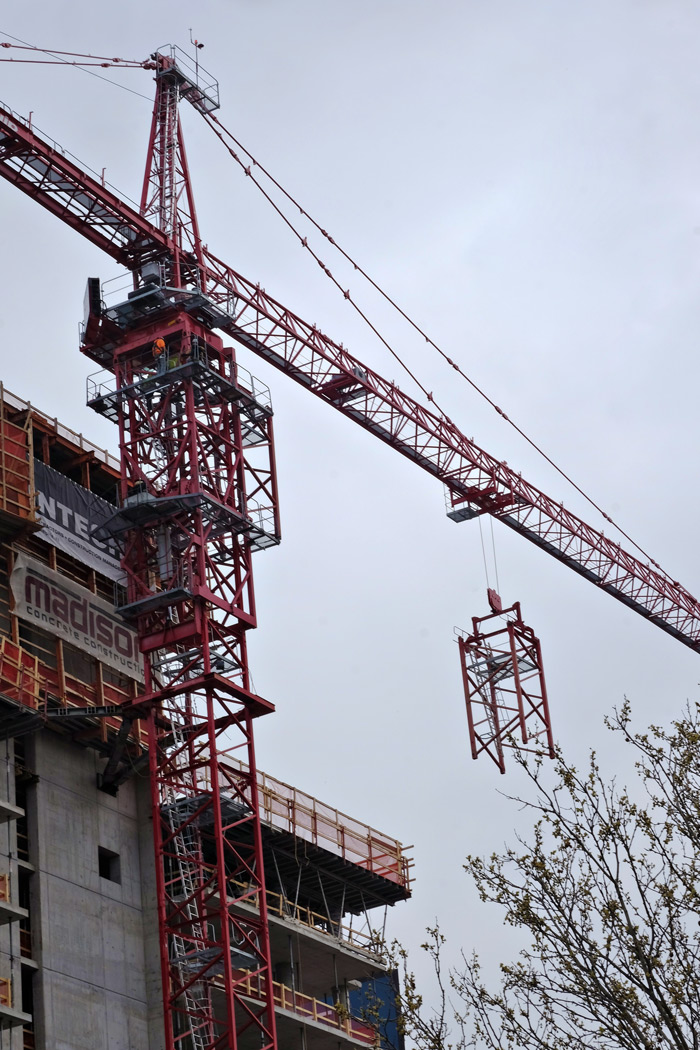 This crane has been caught in the act of growing itself. The object it's lifting into the air is a 20-foot section of crane-tower that it is about to swing into place to lengthen its own neck and make itself taller. The new section will be inserted at the top of the neck, which is currently at a level near the top of the building, where a sort of cage structure surrounds the tower.
This crane has been caught in the act of growing itself. The object it's lifting into the air is a 20-foot section of crane-tower that it is about to swing into place to lengthen its own neck and make itself taller. The new section will be inserted at the top of the neck, which is currently at a level near the top of the building, where a sort of cage structure surrounds the tower.
This cage is called a climbing frame, and it costs $60,000 to rent for a weekend. For a crane that wants to grow itself, the climbing frame is the secret to the whole pulling-itself-up-by-its-own-bootstraps thing.
The climbing frame is installed around the top of the crane's neck, just below the horizontal part of the crane, which does all the heavy lifting. The horizontal arm, with its gears and motor, has to be unbolted from the tower and settled onto the top of the climbing frame. Hydraulic jacks in the frame then boost it up, leaving a gap in the tower. The crane simply picks up a new section of tower and slips it into the gap.
Over the course of a few hours on Monday, this crane grew by six sections, 120 feet. We're told it's now as tall as it needs to be for the project–condos, of course, along the Schuylkill riverfront. In June, the crane guys say they'll be back to dismantle the whole thing and move it to its next job.
How will it ungrow itself? It can't. It's not a cannibal. Sometimes the crane will haul up a second, smaller crane onto the roof of the finished building, and the smaller crane will then lower the pieces of the big crane. To get the second crane down, they sometimes have to use a third, even smaller crane, which can be disassembled into pieces small enough to go down the elevator.

work
construction
crane
condominiums
Schuylkill riverfront
(Image credits: Fuji T)


 Pigeons take care of a freshly poured concrete sidewalk in Los Angeles, January 17, 1956.
Pigeons take care of a freshly poured concrete sidewalk in Los Angeles, January 17, 1956.

 We have nothing to say.
We have nothing to say.







